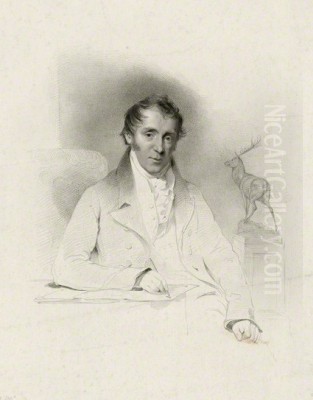
Robert Hills (1769-1844) stands as a significant figure in the history of British art, particularly celebrated for his mastery of watercolour and his dedicated portrayal of animals and rural life. Active during a transformative period for British art, Hills carved a distinct niche for himself through meticulous observation, technical proficiency, and a deep affinity for the natural world. Though perhaps not as universally renowned as some of his contemporaries like J.M.W. Turner or John Constable, Hills played a crucial role in the elevation of watercolour painting and left behind a substantial body of work admired for its detail and charm.
Early Life and Artistic Formation
Born in Islington, London, on June 26, 1769, Robert Hills embarked on his artistic journey at a young age. His initial training was under the guidance of John Alexander Gresse, a drawing master of Swiss origin based in London. Gresse, known for his topographical drawings and as a teacher to several aspiring artists, likely provided Hills with a solid foundation in draughtsmanship.
Seeking further refinement, Hills enrolled in the prestigious Royal Academy Schools in 1788. The Royal Academy, founded two decades earlier under the patronage of King George III with Sir Joshua Reynolds as its first president, was the epicentre of artistic training and exhibition in Britain. Studying here exposed Hills to the highest standards of academic art and allowed him to learn alongside other talented students, although specific records of his close interactions during this period are scarce. He first exhibited at the Royal Academy's annual exhibition in 1791, marking the public commencement of a long and productive career.
The Rise of Watercolour and the Society of Painters in Water Colours
The late eighteenth and early nineteenth centuries witnessed a remarkable flourishing of watercolour painting in Britain. Initially often regarded as a medium primarily for preparatory sketches or topographical records, artists began exploring its full potential for finished, exhibition-worthy pictures. Hills emerged as a key proponent of this movement.
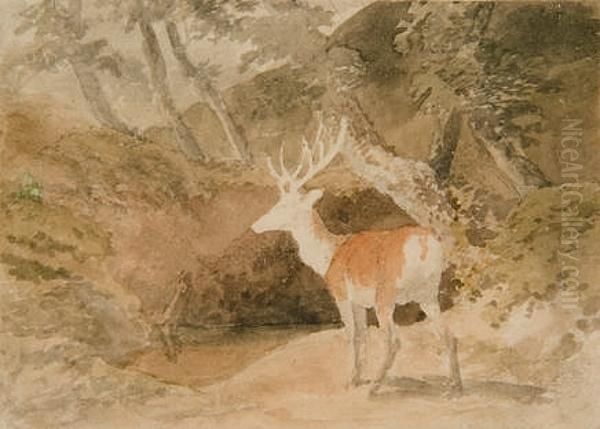
Frustrated by the Royal Academy's perceived bias towards oil painting, where watercolours were often poorly hung or given secondary status, Hills joined forces with a group of fellow artists. In 1804, they established the Society of Painters in Water Colours (often referred to as the Old Water-Colour Society, or OWCS, and later becoming the Royal Society of Painters in Water Colours, RWS). This groundbreaking initiative provided a dedicated venue for exhibiting and promoting watercolour art.
Hills was not merely a member; he was a driving force behind the society's formation and early success. He served as its first Secretary from 1804, managing its affairs with diligence. His commitment was further demonstrated when he later took on the role of Treasurer and served as the society's President between 1827 and 1831. Other founding members included prominent watercolourists such as William Frederick Wells (the first President), Samuel Shelley, William Sawrey Gilpin, Nicholas Pocock, John Varley, Cornelius Varley, and George Barret Jr., highlighting the collective ambition to elevate their chosen medium.
Artistic Style: Precision and Naturalism
Robert Hills developed a distinctive artistic style characterized by meticulous detail, careful observation, and a profound sympathy for his subjects, particularly animals. His primary focus was on the creatures inhabiting the British countryside: cattle, sheep, donkeys, pigs, and especially deer became recurring motifs in his work.
His approach was rooted in direct study from nature. Hills spent considerable time sketching outdoors, capturing the specific forms, textures, and postures of animals. Unusually for the time, he also undertook detailed anatomical studies, examining the underlying bone and muscle structure of animals. This scientific curiosity informed his art, lending his depictions an accuracy and solidity that distinguished them from more generalised or sentimental portrayals.
While animals were often the stars, Hills skillfully integrated them into convincing landscape settings. His backgrounds typically depict rustic farmyards, wooded glades, or gentle pastoral scenes, rendered with the same attention to detail. He favoured a relatively subdued palette, often employing soft grey-blues, earthy browns, and greens, using delicate washes and precise linework to define form and create atmosphere. His technique often involved careful drawing followed by layered washes, sometimes incorporating fine pen work or subtle touches of bodycolour for highlights.
His dedication to animal subjects places him in a lineage of British animal painters stretching back to Francis Barlow in the 17th century and alongside contemporaries like Sawrey Gilpin and the powerful animal painter James Ward. While artists like George Morland captured the broader rustic genre, Hills focused intently on the animals themselves.
Master Etcher: Etchings of Quadrupeds
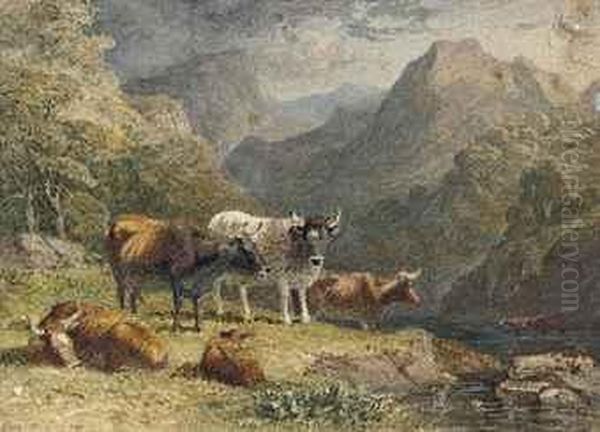
Beyond his prolific output in watercolour, Robert Hills was also a highly accomplished etcher. Etching, a printmaking technique allowing for fine lines and tonal variations, suited his detailed style well. His most significant contribution in this medium is the monumental series titled Etchings of Quadrupeds.
Published in parts between 1798 and 1815, this ambitious project eventually comprised over 1000 individual etchings. The series showcased the full range of his animal subjects, featuring studies of domestic and wild animals, often depicted individually or in small groups, sometimes with landscape vignettes. These etchings served both as independent works of art and potentially as a resource for other artists and students.
The Etchings of Quadrupeds demonstrates Hills's profound understanding of animal anatomy and character, captured through intricate line work and subtle tonal modelling. The sheer scale of the project underscores his dedication and industry. His precise, naturalistic approach in etching contrasts with the more satirical or topographical work of contemporary etchers like Thomas Rowlandson, aligning more closely, in its observational focus, with the natural history engravings of Thomas Bewick, though Hills's work possessed a distinct artistic softness and painterly quality even in print.
Collaborations and Professional Life
Hills's reputation as a skilled animal painter led to occasional collaborations with fellow artists. It was not uncommon during this period for landscape painters to enlist specialists to add figures or animals to their compositions. Hills lent his expertise to several prominent watercolourists who were also members of the Society of Painters in Water Colours.
He is known to have added animal figures to the landscapes of George Barret Jr., whose father was a founding member of the Royal Academy. He also collaborated with George Fennell Robson, known for his dramatic mountain scenery and depictions of the Scottish Highlands, and with William Henry Pyne, an artist and writer famed for his picturesque depictions of British life and costume, notably in The Microcosm of London. These collaborations highlight Hills's standing within the artistic community and the specific demand for his specialized skills.
Throughout his career, Hills remained actively involved in the London art scene, primarily through his unwavering commitment to the Society of Painters in Water Colours. He exhibited regularly at the society's annual shows for decades, contributing significantly to its continued success and reputation. He also continued to exhibit occasionally at the Royal Academy and the British Institution.
Later Career and Technique Evolution
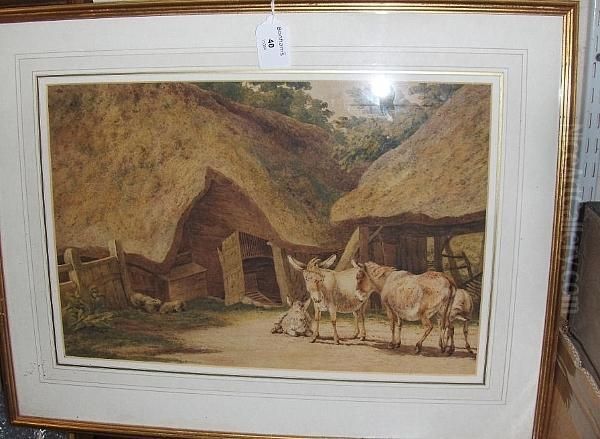
As Hills's career progressed into the 1820s and 1830s, his style continued to evolve, though not always to universal acclaim. Some critics and later commentators noted a tendency towards a more elaborate and perhaps overworked finish in his later watercolours. While his early work was praised for its clarity and directness, some later pieces featured extensive use of stippling (applying colour in small dots or short strokes) and minute touches, which occasionally detracted from the broader effect or freshness seen in his earlier sketches and studies.
However, this evolution also reflects the changing tastes and technical explorations within watercolour painting during the period. Artists were continually pushing the boundaries of the medium, striving for greater depth, richness, and finish, sometimes emulating the effects of oil painting. Hills's later technique, while sometimes criticized for excessive labour, demonstrates his ongoing engagement with the technical possibilities of watercolour.
Despite any stylistic debates, his commitment to his core subjects remained constant. He continued to produce detailed and sensitive studies of animals and rural scenes until late in his life, maintaining a high level of technical skill and observational acuity.
Legacy and Influence
Robert Hills died in London on May 14, 1844, at the age of 74. He left behind a legacy as one of Britain's foremost animal painters in watercolour and a significant figure in the professionalization and promotion of the medium. His role as a founder and long-serving officer of the Society of Painters in Water Colours was instrumental in establishing watercolour as a respected art form in its own right.
His influence is perhaps most keenly felt in the tradition of British animal painting and detailed landscape watercolour. His meticulous approach and anatomical understanding set a high standard for naturalistic representation. While later artists like Sir Edwin Landseer would achieve greater fame for their dramatic and often anthropomorphized animal subjects in oil, Hills's quieter, more observational watercolours and etchings hold a distinct place, valued for their accuracy and charm.
His dedication to capturing the textures of fur, the specific postures of deer, or the placid nature of cattle provided a rich visual record of British rural life before the full impact of the Industrial Revolution. Later watercolourists, such as Myles Birket Foster, continued the tradition of detailed, often idyllic, depictions of the countryside, echoing Hills's commitment to careful rendering, albeit often with a more overtly sentimental tone.
Representative Works
Identifying single masterpieces can be challenging given Hills's prolific output and focus on studies and variations on themes. However, several works and series stand out:
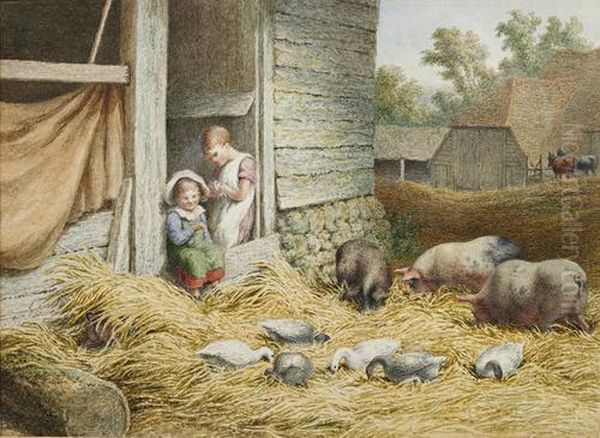
Etchings of Quadrupeds (published 1798-1815): This extensive series remains his most significant achievement in printmaking, showcasing his encyclopedic knowledge of animal forms.
A Stag (examples exist from various dates, e.g., 1827): Deer were a favourite subject, and his depictions of stags, often set in wooded landscapes, capture their noble bearing and anatomical structure with great skill. These are among his most characteristic watercolours.
Studies of Cattle, Sheep, and Donkeys: Numerous watercolours focus on these farm animals, often depicted resting, grazing, or watering in pastoral settings. Works like Cattle in a Landscape or Donkeys by a Barn exemplify his typical subject matter and detailed style.
Farmyard Scenes: Hills frequently depicted the activity and inhabitants of farmyards, combining animal studies with rustic architecture and landscape elements.
Snow Scenes: Particularly noted from the period around 1815-1819, Hills produced several atmospheric watercolours depicting animals in snow-covered landscapes, demonstrating his ability to capture different weather conditions and light effects.
His works are held in major collections, including the British Museum, the Victoria and Albert Museum, the Tate Britain, and numerous regional galleries in the UK, as well as collections internationally.
Conclusion
Robert Hills was an artist defined by dedication, precision, and a deep connection to the natural world. As a watercolourist, he combined technical finesse with keen observation, creating intimate and accurate portrayals of British animals and landscapes. As an etcher, his Etchings of Quadrupeds stands as a remarkable testament to his skill and industry. Crucially, his role in founding and nurturing the Society of Painters in Water Colours helped secure a lasting place for the medium within the British art establishment. While his style remained largely within the bounds of early nineteenth-century naturalism, his focused expertise and the sheer quality and volume of his output ensure his enduring importance as a master of animal art and a key figure in the golden age of British watercolour.